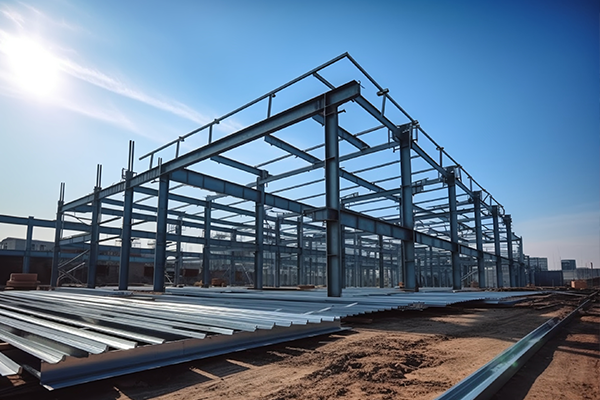NewsDetails
The Steel Skeleton: The Invisible Backbone of Modern Architecture
author:Tianxing time:2025-06-02 18:00:18 Click:143
I. What is Steel Structure?
Simply put, a steel structure is a form of building construction where steel (primarily various types of structural steel) serves as the primary load-bearing skeleton. It doesn't mean the entire building is made of steel, but rather that its "bones" — core load-bearing components like beams, columns, trusses, and braces — are factory-fabricated steel elements assembled on-site through welding, bolting, or riveting.
II. The Extraordinary Advantages of the Steel Skeleton
Steel structures dominate modern construction thanks to a series of exceptional properties:
Exceptional Strength: Steel offers high strength and stiffness (resistance to deformation). Under the same load, steel members have smaller cross-sections and are significantly lighter than concrete or timber equivalents. This forms the physical basis for creating buildings with larger spans and greater heights.
Remarkable Ductility: Steel possesses excellent ductility and toughness. This means it can deform significantly (like a spring) under extreme forces like strong winds or earthquakes, absorbing energy rather than fracturing brittlely. This greatly enhances seismic and wind resistance, ensuring structural safety.
Rapid Construction: The core appeal of steel structures lies in industrialized fabrication and on-site assembly. Steel components are precision-manufactured in controlled factory environments, ensuring quality. On-site, they are assembled quickly like "building blocks," minimizing weather delays. This significantly shortens construction schedules (30%-50% faster than traditional concrete structures) and reduces noise and dust pollution.
Master of Spanning Space: Thanks to its high strength-to-weight ratio, steel easily achieves vast spans difficult or impossible for concrete. The column-free, open spaces of airport terminals, sports stadiums, large exhibition halls, and industrial plants are the natural "stage" for steel structures.
Green Pioneer (Sustainability): Steel is 90% recyclable. At the end of a building's life, dismantled steel can be melted down and reused, with far less resource depletion than concrete. Factory prefabrication also reduces construction waste. Furthermore, the lightweight nature reduces foundation requirements, saving materials.
III. Where Steel Shines: Ubiquitous Applications
Steel structures are integral to countless aspects of modern life:
The Spine of Skyscrapers: The core tubes and massive outer frames of super-tall buildings rely heavily on the strength and speed of steel construction.
The Wings of Long-Span Structures: The magnificent roofs of stadiums (like the "Bird's Nest"), airport terminals, convention centers, large theaters, and high-speed railway station canopies are almost exclusively feats of steel engineering.
The Pillars of Industry: Heavy industrial plants, power stations, and petrochemical facilities requiring immense load capacity and resistance to vibration depend on the reliability of steel structures.
Bridges Across the Divide: Large highway bridges, railway bridges (especially cable-stayed and suspension bridges), and pedestrian overpasses widely utilize steel for its spanning capabilities and construction efficiency.
Agile Spaces & Rapid Deployment: For temporary buildings, modular housing, prefabricated structures, and emergency shelters requiring fast construction, steel is the ideal solution.
IV. Addressing Steel's Achilles' Heels
Steel has vulnerabilities, but modern technology provides effective countermeasures:
Fear of Fire (Fire Resistance): Steel loses strength rapidly at high temperatures (around 550°C / 1022°F). Solution: Apply fire-resistant coatings (intumescent paint), encase in fireproof boards/sprayed fire-resistive materials (SFRM), or fill with concrete (forming composite structures) to provide a "fire-resistant armor," meeting required fire ratings.
Fear of Rust (Corrosion Resistance): Steel exposed to moisture and corrosive environments will rust. Solution: Treat components with hot-dip galvanizing before leaving the factory, or apply high-performance protective coatings/paints to create a barrier. Regular maintenance is also crucial.
V. Future Trends: Smarter, Greener, More Efficient
Steel structure technology continues to evolve rapidly:
High-Strength Steel: Steels with ever-higher strengths (e.g., ASTM A913 Gr. 65, S460, S690) enable lighter structures and greater spanning capabilities.
Digitalization & BIM: Building Information Modeling (BIM) integrates design, fabrication, and construction, enabling precision and collaboration. Robotic welding and automated cutting enhance manufacturing accuracy and efficiency.
Advanced Composite Structures: Hybrid steel-concrete composite systems (like concrete-filled steel tubes - CFTs, composite beams) combine material strengths for superior performance and broader application.
Modularization & Integration: Steel is inherently suited for modular construction. Future buildings may involve factory-produced volumetric modules ("boxes") stacked and integrated rapidly on-site.
Conclusion
The steel skeleton, forged by human ingenuity, silently underpins the skylines and spatial dreams of our era with its exceptional mechanical properties, efficient construction methods, and sustainable potential. From towering pinnacles to bridges spanning rivers, from arenas holding thousands to high-performance factories, it is not only a carrier of strength and beauty but also a symbol of humanity's relentless push against spatial limits, pursuing architectural artistry and engineering efficiency. Next time you stand within a magnificent structure, take a moment to notice the steel beams and columns above or beside you – feel the solid power of modern civilization they represent.
 Recommended Products
Recommended Products
 Contact us
Contact us
—— Contact:Ms. Zhang
—— Tel:(+86)18399688883
—— Email:18399688883@163.com
—— Url:https://www.tianxingmaterials.com
—— Address:Horgos City, Ili Kazakh Autonomous Prefecture, Xinjiang, China







